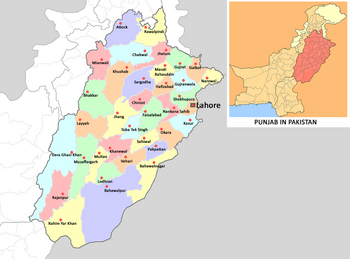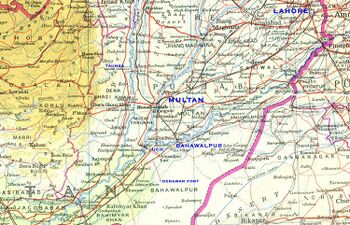Dera Ghazi Khan


Dera Ghazi Khan (Hindi: डेरा ग़ाज़ीखान, Saraiki, Urdu: ڈیرہ غازی خان) is a city and District in Punjab province, Pakistan.
Origin
The city was founded at the close of the 15th century and named after Nawab Ghazi Khan Mirrani.
Tahsils in the District
- Dera Ghazi Khan
- Taunsa Sharif
- De-Excluded Area (Tribal Area)
Jat clans in Dera Ghazi Khan District
According to 1911 census, the following were the principal Muslim Jat clans in Dera Ghazi Khan District [1]:
Aishiani (1,058), Awan (1,238), Babbar (4,294), Barra (1,927), Batwani (895), Bhatti (9,128), Bhutta (2,876), Buttar (1,292), Bab (5,257), Barar (501), Bohar (1,445), Chachar (1,898), Chhajra (913), Chhina (706), Changar (861), Chani (572), Chauhan (1,026), Dhandla (949), Daha (1,016), Dakhna (1,303), Darakhe (785), Dhol (638), Domra (822), Ghani (628), Hanbi (769), Heer (387), Hujan (733), Johiya (1,617), Jajalani (1,571), Kajla (558), Kanera (208), Kang (10), Khatti (612), Kachela (1,848), Kabru (554), Khak (556), Khaloti (720), Khera (567), Khokhar (3,465), Lakaul (1,157), Lak (658), Langah (1,558), Mahar (702), Mahesar (648), Metla (776), Mohana (663), Mulana (1,358), Malhan (529), Mangil (656), Manjotha (4,348), Meo (524), Makwal (1,091), Otrai (718), Parhar (1,144), Panwar (866), Phor (867), Sahota (994), Sandhila (1,082), Soomra or Soomro (2,508), Sambar ( 2,030), Shahkhani (961), Sial (3,915), Samdana (895), Thaheem (1,499) and, Virk (548)
History
The city was founded at the close of the 15th century and named after Nawab Ghazi Khan Mirrani, son of Nawab Haji Khan Mirrani, a Balochi chieftain, who had declared independence from the Langhi Dynasty Sultans of Multan. Together with two other Deras i.e. settlements, Dera Ismail Khan and Dera Fateh Khan, it gave its name to Derajat. Derajat eventually came into the possession of the British after the Sikh War in 1849 and was divided into two districts: Dera Ghazi Khan and Dera Ismail Khan. After the partition of India, many of the city's Hindu residents settled in Derawal Nagar colony of Delhi, India.The district of Rajanpur was later carved out of the Dera Ghazi Khan district. Some of them also settled in various part of India, including Bhiwani, Delhi, Jhansi, Ranchi, Ambala and Haridwar. DG Khan was most famous seat of Krishna (Hindu avatar of God Vishnu) worship , in north west India ,where Lord Krishna was fondly referred as "Thakur Gosain" by devotees. After partition of India, the Lord Krishn Moorat was shifted to a new temple at Railway road , Gurgaon.
Dera Ghazi Khan was founded in 15th century by Amar a Tribal Sardar of Mirani tribe. The old city of Dera Ghazi Khan was situated at the distance of 16 km towards east of the present city. In 1908, the old city was destroyed due to flash floods from heavy rains overflowing the River Indus. The present city was established in 1910. The city is divided into different blocks. The British Raj established colonial system in the continent and declared Dera Ghazi Khan as district in the year 1849. General Courtland was appointed as first Deputy Commissioner of this District. Keeping in view the rapidly increasing population of the area and deteriorating law and order situation district Dera Ghazi Khan was divided in two districts i.e. Dera Ghazi Khan and Rajanpur. Presently there are two revenue sub division of the District. A tribal belt/political area spread along with western side of the District.
जाटों का विस्तार
डॉ रणजीतसिंह[2] भारत भूमि में जाटों के विस्तार को देखते हुए योगेन्द्रपाल शास्त्री [3] ने लिखा है कि ...."जाट अपने आदि देश भारतवर्ष के कोने-कोने में नहीं वरन उपजाऊ प्रदेशों की ऊंची भूमियों पर बसे हुए हैं। नदियों की अति निकटवर्ती खादर भूमि या पहाड़ों की तलहटी में उनकी सामूहिक विद्यमानता नहीं पाई जाती। डेरा गाजी खां, डेरा इस्माइल खां, डेरा फतेह खाँ, बन्नू, कोहाट, हजारा, नौशेरा, सियालकोट, गुजरात, गुजरान वाला, लायलपुर, मिंटगुमरी, लाहौर की चुनिया तहसील में कुल मिलाकर 25 लाख जाट आज भी बसे हुए हैं। यद्यपि इनका धर्म है इस्लाम है किंतु रक्त की दृष्टि से जाट होने का उन्हें गर्व है। विभाजित भारत में जाटों की संख्या किसी भी प्रकार कम नहीं है। "
Notable persons
External links
References
- ↑ Census Of India 1911 Volume xiv Punjab Part 2 by Pandit Narikishan Kaul
- ↑ Jat Itihas By Dr Ranjit Singh/1.Jaton Ka Vistar,p. 6
- ↑ योगेद्रपाल, क्षत्रिय जातियों का उत्थान और पतन, पृष्ठ 271-73
Back to Pakistan

